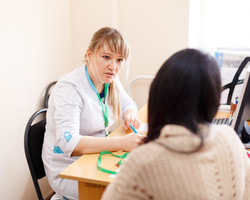Better than screening: with WHO’s help Ukraine chose a cost-efficient policy to prevent breast cancer

WHO/Jerome Flayosc
International Women’s Day (IWD), 8 March is an opportunity to highlight a health issue that affects up to 1 out of 10 women in many countries of the European Region - an inspiring story of Ukraine’s search for the best tool to fight breast cancer. The country’s authorities used WHO/Europe’s expertise and advice to change their initial plans for nationwide mammography screening and started developing a more promising early diagnosis programme. The move will save Ukraine thousands of lives and millions of euros in loans.
Breast cancer prevention: finding best practices
A recent study conducted by IARC and EURO has shown that in Ukraine, more than 1 out of 4 breast cancers are diagnosed at late stage making cure out of reach, even with the best treatments. To break this worrying trend, Dr Arman Kacharian, the lead for cancer control at the Ministry of Health of Ukraine, reached out to WHO/Europe for their expertise in this field.
In 2019-2020 he discussed effective breast cancer prevention policies at the IARC/WHO workshop on cancer screening and the large WHO/Europe screening conferences, where he came to conclusion that a large scale mammography screening program would not be the best option for Ukraine to improve its situation with breast cancer.
According to the latest WHO guidelines, nationwide mammography cancer screening programmes tend to be expensive and only demonstrate positive results in countries where health systems get vast economic and human resources. Health systems of many countries of the WHO European Region are unable to test large numbers of healthy women and ensure rapid and accurate diagnosis and follow up for those tested positive.
After consultation with WHO/Europe experts, Ukraine’s authorities became interested in another WHO-recommended cancer prevention strategy – the early diagnosis programme. It is based on the rapid identification of cancer in patients who have symptoms of the disease and rapid full diagnosis follow up. Given the major improvements in breast cancer treatment in the past decades, in cases when breast cancer is diagnosed at early palpable stage, the rates of secure cure are very high.
Early diagnosis programme: what are the benefits?
Cancer, when identified early, is more likely to respond to effective treatment, resulting in a greater probability of surviving as well as less heavy and expensive treatment. The value of detecting cancer early is clear, and significant improvements can be made in the lives of cancer patients.
“In comparison to mammography screening programme, centralization of advanced centers providing high-quality early diagnosis of breast cancer is more efficient, economical and sustainable in a setting with limited resources ”, said Dr Olga Trusova, a leading Belarusian mammography expert who took part in the BELMED project aimed at implementation of breast cancer screening in Belarus. BELMED was funded by the EU and implemented by WHO/Europe and IARC since 2016.
WHO/Europe organized a series of online consultations between Dr Kacharian and Dr Trusova to share views and expertise on cancer prevention policies.
The early diagnosis approach for breast cancer was recognized as more appropriate for Ukraine than mammography screening. It is less resource intensive and allows Ukrainian health system to better prepare for future screening measures if needed.
Saving Ukraine’s resources
WHO/Europe has also helped Ukraine to assess its resources. The country has been collaborating with France on breast cancer prevention projects. In early 2020 France proposed a soft loan of 24 million euros to Ukraine to buy mammography machines for screening.
Following advice of WHO/Europe experts, Ukraine performed a rapid mapping of the mammographic facilities available in the country matching them with the national data on breast cancer detection stratified by regions, including the data from the Ukrainian breast cancer screening pilot programme.
It turned out the country had sufficient mammographic equipment to start an efficient early diagnosis breast cancer programme. It was only needed to ensure the existing mammography units worked in full capacity, dealing with more than 4 to 8 women a day as some does presently.
“The help from WHO saved a lot of money for Ukraine”, said Dr Kacharian, “The soft loan was intended for purchase of mammography units. If we don’t need this equipment, we won’t have to reimburse the loan. We`ll renew mammography equipment in oncological specialized hospitals for organizing one day diagnostic program”. WHO/Europe is involved in the discussions where Ukraine is now negotiating with France to see how to invest more efficiently in breast cancer control.



